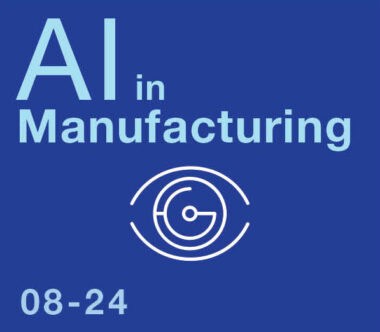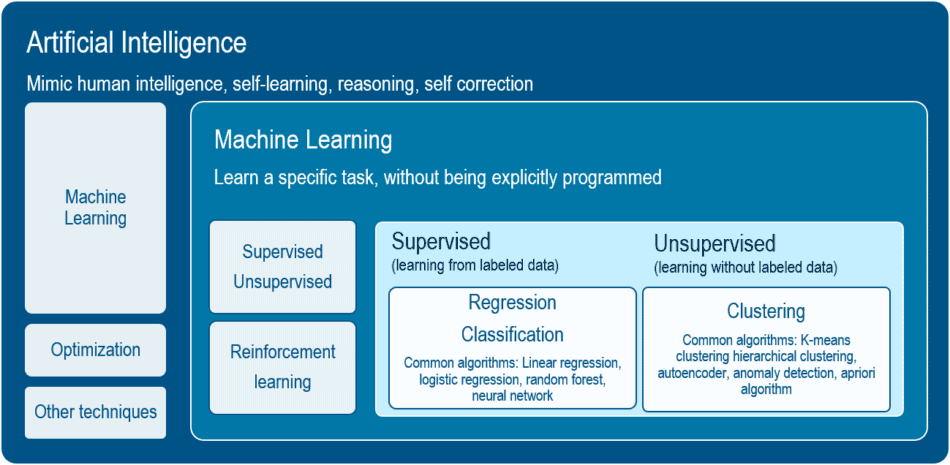Unlocking AI and ML’s Potential in Manufacturing

Demystifying AI and ML to uncover seamless integrations to improve planning, manage disruptions, and enhance operational efficiency

TAKEAWAYS:
● AI and ML significantly improve production execution, predictive maintenance, and scheduling, leading to higher quality, reduced downtime, and optimized operations.
● Successful AI/ML integration requires robust data management, cross-functional collaboration, scalable pilot projects, continuous performance monitoring, and staff training.
● Emerging technologies like Generative AI, synthetic data, and autonomic systems promise to revolutionize manufacturing with self-optimizing operations and advanced model training techniques.
AI Manufacturing Use Cases
There are many different application areas for AI across manufacturing and production. Even limiting the scope to just “within the four walls of the shop floor,” one could write a novel on all the possibilities (let alone thinking about supply chain and beyond).
These three use cases represent some of the most typical and prominent opportunities for a manufacturing leader.
- Production Execution – For example, AI-driven quality control systems inspecting products in real-time, ensuring consistent quality and minimizing waste.
- Predictive Maintenance – For example, AI continuously monitoring equipment health and ML predicting potential failures, together with the goal of reducing downtime and maintenance costs.
- Production Scheduling – For example, AI optimization creating constraint based schedules and ML analyzing historical schedule performance to drive increased throughput and resource utilization.
Each of these use-cases have typically been managed by spreadsheets, legacy systems or just “tribal knowledge” in the past, but today’s manufacturing and product complexity means that only AI and ML algorithms can now effectively process and analyze the vast amounts of production data in real-time, to help humans make confident and effective plans and decisions.
1. Optimizing Production Execution with AI and ML
Even simple manufacturing operations generate tremendous amounts of data. Although still a challenge, the easier part of the task is to collect the data from the various sensors and machinery across the shop floor. Once collected, manufacturers can start to leverage AI’s power.
The first, immediate, benefit is visualization of the data collected. For humans, that can be helpful if there are obvious anomalies in what is seen, but most manufacturing problems have root causes that run deeper than obvious and isolated deviations. For example, product defects that present as a lack of worker training but are actually defects related to raw material quality.
AI can efficiently identify anomalies in real-time as the data is collected, and then correlate the data with upstream and downstream processes to identify associated processes that might show causation between the processes and therefore identify the root cause. Doing this in real-time allows immediate adjustment to production runs (especially in batch environments) that can prevent wasted time and material.
“By reducing unplanned downtime, manufacturers can extend equipment lifespan and increase overall production efficiency at reduced costs.”
Because this data is continuously collected, ML can be applied to the historical data store to reveal additional insights and patterns that can help drive future improvements. For example, ML can analyze quality data to identify subtle trends in material or production tolerances that may be leading to failures that are more critical. It could also predict and optimize energy consumption dynamically, which can lead to more sustainable production practices.
Taken a step further, AI and ML could be entrusted to not only identify current and future problems, but to autonomously adjust production parameters in real-time to optimize performance and respond to changing conditions without the need for human intervention. This, of course, requires a certain level of trust between man and machine – more on that in a moment.
2. Predictive Maintenance Using AI and ML
Despite the best production control and execution, one challenge that every manufacturer deals with is machine maintenance – both planned and (more challenging) unplanned. Just as AI and ML can optimize product quality, the same principles can apply to production resources.
Predicting maintenance problems mitigates the disruption that they cause. Continuous monitoring of equipment performance and health via sensors provides a wealth of data that can feed ML algorithms. These algorithms are adept at developing insights into the probability of unplanned downtime based upon historical frequency and patterns of past machine performance. This means manufacturers will be able to see predictive alerts that can then use to prepare for potential problems: either pro-actively accelerating scheduled maintenance or planning for additional capacity.
Machine failures not only affect finished products but also the asset intensive machine equipment. By reducing unplanned downtime, manufacturers can extend equipment lifespan and increase overall production efficiency at reduced costs.
Does AI (optimization) play a role in predictive maintenance? Not as much in the prediction or prevention of downtime, but it certainly is the hero when disruption hits the production line.
3. AI and ML Applications in Production Scheduling
The famous statistician W. Edwards Deming said, “Uncontrolled variation is the enemy of quality.” This is absolutely the case in manufacturing, and manufacturers can easily add “efficiency,” “cost” and several other nouns to “quality.” One of the key Industry 4.0 attributes that companies are seeking is “agility” – the ability to react to change as it happens with confident decision-making. AI (specifically optimization) can be applied to this requirement with great effect.
Even simple manufacturing operations contain too many constraints and variables to allow for manual scheduling of jobs with any level of precision. Spreadsheets and manual scheduling simply are not capable of optimizing production against operational goals, let alone providing decision support for possible alternative plans. AI optimization excels at being able to consider millions of potential combinations of material, capacity and skill-based constraints while searching for plans that meet stated KPIs, such as order fulfillment, changeovers, etc.
This ability to create an optimal production schedule in seconds (compared to hours or days) means manufacturers can instantly react to changes in orders, capacity or material. Additionally, they can experiment with multiple “what-if?” scenarios to evaluate trade-offs and opportunities to meet more corporate goals.
ML also plays a role in this area. Since no plan survives contact with the real world, it is inevitable that unforeseen changes will affect even the most promising plans. In the same way that historical machine data can be reviewed to predict failures, ML can mine the performance of previous plans to analyze whether there are patterns that reveal how future schedules can be additionally adjusted to improve their effectiveness.

Implementing AI and ML Solutions in Manufacturing
There are lots of use-cases and lots of benefits, but where and how to start? The most obvious common foundation might be the reliance of these technologies on data.
AI and especially ML, require large amounts of accurate data (and in real-time in many cases). Therefore, manufacturers will need to implement robust data collection and management practices to ensure that the data feeding into AI/ML models is accurate and reliable. This might also mean a strategy and investment into 5G and IIoT, since the data will be coming from sensors and IoT devices that collect real-time data from production equipment.
Beyond simply collecting the data, several other typical project items also deserve consideration:
- Foster collaboration between IT, data science, and operational teams to ensure alignment and effective implementation of AI and ML solutions. Example: Create cross-functional teams comprising members from manufacturing, IT, and data science to oversee the AI/ML integration process.
- Begin with small-scale pilot projects to test the feasibility and impact of AI/ML solutions before full-scale implementation. This approach helps manage risks and identifies potential issues early. Example: Implement a pilot project for predictive maintenance on a few critical machines to validate the technology’s effectiveness.
- Design AI/ML solutions with scalability in mind, allowing for easy expansion as the technology proves its value. Example: Develop modular AI/ML solutions that can scale across different production lines or facilities as needed.
- Regularly monitor the performance of AI/ML models and make necessary adjustments to improve accuracy and efficiency. Example: Implement a feedback loop to continuously assess model performance, and make improvements based on real-world data.
- Provide training for staff to understand and work with AI/ML technologies, ensuring they are equipped to leverage these tools effectively. Example: Conduct workshops and training sessions to upskill employees in AI/ML concepts and tools.
- Consider AI & ML “as a service.” Vendors are now starting to offer MLaaS to manufacturers that do not have the required skillset or budget to implement a long-term strategy, yet need an answer to a specific problem or challenge. By contracting with a vendor for an “outcome,” they can leverage AI or ML to solve key strategic problems while offsetting the cost of software licenses, IT overhead and additional skilled staff.
This last item has an underlying issue that is reminiscent of the continuing references to the “Skynet” of Terminator movie fame: trust in AI. While it is unlikely that a production scheduler is going to trigger the “rise of the machines,” the general complexity of AI/ML, data, and the scope of application means that much of the actual workings of the algorithms are difficult, if not impossible to comprehend. In other words, the output, or “what,” is understandable but the “why” is often not. In fact, the output may even seem counter-intuitive to one’s own gut-feel. Sometimes, this is because the technology is sacrificing particular operational metrics to achieve a greater goal.
For example, an optimized production schedule might meet the primary KPI of “order fulfillment” at the expense of OEE for particular resources. On the shop floor, a human scheduler might see this as a flaw in the plan and attempt to “tweak” the schedule to keep the resource loaded when, in fact, this will affect the plan in negative ways and reduce overall business objectives.
This “trust in AI” is something that will certainly change over time. In the meantime, you can add one additional practical step to the project plan to help:
- Communicate the benefits and potential of AI/ML solutions to all stakeholders to mitigate resistance and encourage adoption. Example: Hold informational sessions and provide case studies demonstrating the positive impact of AI/ML on similar manufacturing operations.
Is it Worth It?
There is obviously some effort and commitment required to implement AI and ML into manufacturing processes but the value is certainly there. By leveraging AI and ML, manufacturers can achieve greater operational agility, reduced costs, and improved decision-making capabilities, positioning themselves competitively in an increasingly complex and dynamic market landscape.
Manufacturers are seeing critical KPIs affected very significantly in the following areas:
- Cost Reduction: In both production efficiency and quality-related costs, improvements up to 50% are possible
- Productivity: By replacing manual decisions with automation, planners are recovering 25-50% of the time for more value-added activities
- Time to Market: More efficient scheduling and execution can accelerate time to market (especially in fast moving sectors) by up to 40%
In addition, the benefits related to equipment maintenance and lifespan can have a significant positive impact on capital expense budgets.
Mileage may vary, of course, so another critical step in the plan is to build a solid business case based upon clearly stated goals and expectations with a realistic state of as-is and to-be. The technology vendors who provide AI and ML are well aware of the capability and complexity of their wares, and so should be willing to work with manufacturers on this step (it is in their best interest after all to ensure a successful long-term partnership).
“Spreadsheets and manual scheduling simply are not capable of optimizing production against operational goals, let alone providing decision support for possible alternative plans.”
Whether manufacturers leverage a technology vendor, consulting partner, or has the expertise in house, they should not skip this step. Even if their executive team has a pot of money and an urgent decree to get on the AI and ML bandwagon, it is imperative to understand why this technology is needed and exactly what element of the possible capabilities will be critical to achieving success and how.
Future Trends and Innovations
The integration of AI and ML into an Industry 4.0 strategy underscores a commitment to innovation and continuous improvement, setting the stage for more sustainable and resilient manufacturing practices. Manufacturers can achieve effective use of AI today (and many companies are already receiving the benefits). But, what of the future? What can we expect from AI in the next decade and beyond?
It would be easy to say, “The possibilities are endless,” and they probably are in many respects. What seemed impossible yesterday is in practice in manufacturing today. Here are some thoughts about what might be possible tomorrow:
- Generative AI for Production Optimization: While this article did not focus on the sub-genre of Generative AI, it has the potential to revolutionize manufacturing by providing powerful tools to optimize production processes. Imagine GenAI developing completely new manufacturing lines or optimization strategies that are not immediately apparent to human operators.
- Synthetic Data for Enhanced Model Training: The use of synthetic data is gaining traction as a method to train AI models without compromising privacy or requiring extensive real-world data collection. Synthetic data can simulate a wide range of operational conditions, enabling robust training of ML models for applications such as predictive maintenance, demand forecasting, and process optimization.
- Autonomic Systems for Self-Optimizing Operations: Autonomic systems utilize AI to automatically adjust and optimize processes without human intervention. These systems continuously learn from operational data, making real-time adjustments to maintain optimal performance. Applications include dynamic scheduling, resource allocation, and process optimization.
It may seem that AI’s evolution will outpace manufacturers’ ability to implement any of its capabilities. This pace of innovation also often causes internal initiatives to move so fast that they can fail. Although AI and ML can be applied to the most complex and strategic processes, they can also be applied to solve very simple and tactical challenges – production scheduling is a perfect example of this. It is a classic situation of not suffering from “analysis paralysis.” In fact, here are four activities every manufacturer could benefit from now:
- Become educated on AI and ML’s fundamentals: it is a large discipline across many industries. Leaders should become confident and articulate on the basic capabilities and how they could be leveraged in manufacturing scenarios.
- Don’t get caught up in the hype: for those just starting out in AI, find the practical use-cases and always work backwards from the business problem, not forwards from the technology capabilities.
- Learn from all voices: there are fast-growing practical experiences in manufacturing and many third party sources and technology experts who are publishing prolifically on this sector.
- Finally, leverage the extensive network and information provided by the MLC and its members. There are extensive resources and experiences just a mouse-click away. M
About the author:

Adrian Wood is Director of Strategy & Marketing at Dassault Systèmes